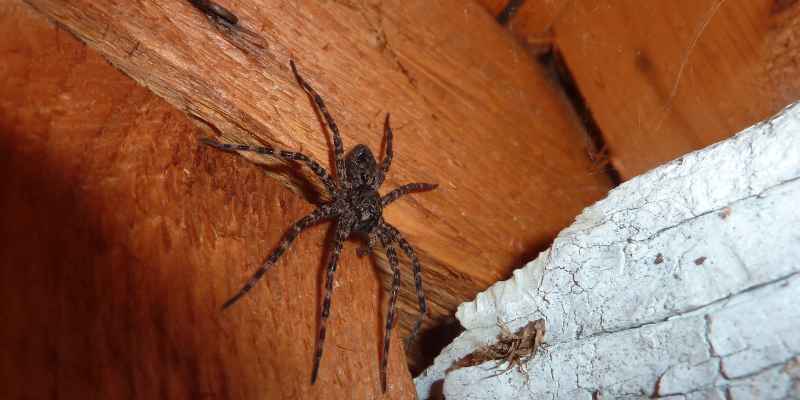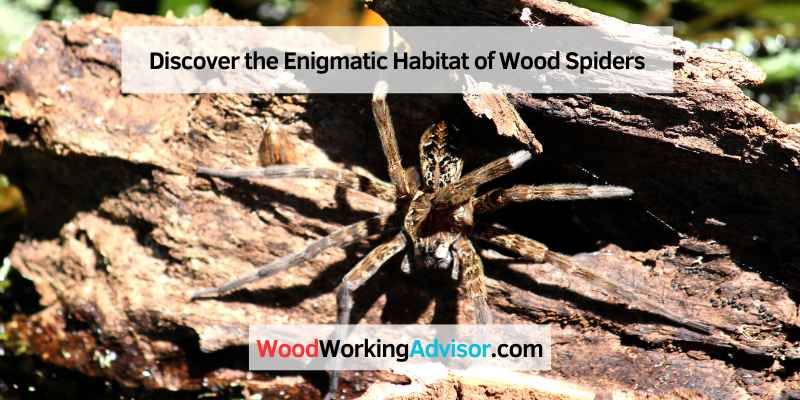Wood spiders commonly live in forested areas, as well as in gardens and woodpiles. They prefer to inhabit places with ample access to prey and hiding spots.
These spiders are often found in dark, sheltered locations, such as under tree bark, rocks, and fallen logs. Additionally, they are also known to spin their intricate webs in the corners of buildings and around outdoor structures. Wood spiders tend to thrive in environments where there is a steady supply of insects for them to catch and feed on, making wooded areas an ideal habitat for them.
Their ability to adapt to various environments allows them to inhabit a wide range of places, making them a common sight in many outdoor settings.
Unveiling Wood Spiders
Wood spiders, scientifically known as Araneidae, are a diverse group of spiders found in various habitats worldwide. These fascinating creatures are known for their intricate webs and unique physical characteristics.
The Diversity Of Wood Spider Species
Wood spiders encompass a wide range of species, each adapted to specific environments. From the dense forests of the Amazon to the leafy canopies of temperate regions, these spiders have established their presence across the globe. With over 3,100 recognized species, wood spiders exhibit an impressive array of adaptations and behaviors.
Physical Characteristics Of Wood Spiders
The physical attributes of wood spiders are distinctive and well-suited to their arboreal lifestyle. Their bodies are often small to medium-sized, allowing them to navigate through the intricate network of branches and foliage. These spiders are also recognized for their intricate web-building skills and keen eyesight, enabling them to capture prey efficiently.

Adaptations To Woodland Life
Adaptations to Woodland Life: Wood spiders showcase remarkable adaptations to thrive in the woodland ecosystems they call home. These adaptations enable wood spiders to navigate their niches effectively and exhibit unique behavioral patterns that aid in their survival.
Behavioral Patterns In Wood Spiders
Wood spiders exhibit cooperative behaviors such as group web-building activities which enhance their collective safety and efficiency.
Niche Selection In Woodland Ecosystems
Wood spiders strategically select their niches based on factors like humidity levels and proximity to prey sources.
Ecosystem Impact
Wood spiders, also known as xylocopids, play a crucial role in the food chain. These spiders are a source of food for several other organisms, particularly predators such as birds, reptiles, and larger spiders. Their presence in the ecosystem ensures a balanced food web, maintaining the population dynamics of both predators and prey.
Influence On Vegetation And Insect Populations
Wood spiders have a direct impact on vegetation and insect populations. They are primarily insectivores, preying on various insects like mosquitoes, flies, and small beetles. By controlling these insect populations, wood spiders help maintain the ecosystem’s balance by preventing the overpopulation of certain insect species that can cause damage to vegetation.
Moreover, wood spiders contribute to biological pest control. By keeping insect populations in check, they reduce the need for pesticide use, which benefits both the environment and human health.
Web Architecture And Function
Wood spiders are fascinating creatures that are known for their impressive web architecture and function. They have evolved intricate web-building techniques and web-based hunting strategies that demonstrate their remarkable adaptability and survival skills.
Intricate Web-building Techniques
Wood spiders are master engineers when it comes to constructing their intricate webs. They start by securing a solid anchor point for their web, often attaching it to tree branches or structures. Once the anchor is established, they meticulously spin silk threads to create the framework of their web.
These skilled spiders carefully position radial lines that extend from the center of the web outward. These lines serve as the foundation for the intricate spiral pattern that makes up the capture area of the web. The spiders then weave sticky spiral threads in a unique pattern, creating an effective snare for unsuspecting prey.
The structure of the web allows the wood spider to maximize its chances of capturing insects. The radial lines and the sticky spiral threads work in tandem to provide support and capture prey efficiently.
Web-based Hunting Strategies
Wood spiders rely on their webs to catch their prey, employing various web-based hunting strategies. Once their web is complete, these spiders patiently wait in the center, remaining motionless until they feel vibrations caused by an insect getting trapped in their web.
When the spider senses prey struggling in the sticky threads, it swiftly moves towards the source of the disturbance. With its excellent vision and agility, it wastes no time immobilizing and subduing the trapped insect, using its venomous bite to ensure a quick and successful capture.
These hunting strategies are adapted to the wood spider’s web architecture, maximizing the effectiveness of their web construction efforts and increasing their chances of capturing food.
Wood spiders’ web architecture and function are a testament to their exceptional adaptation skills. their intricate web-building techniques and web-based hunting strategies are perfectly crafted to ensure the survival of these remarkable arachnids.
Reproduction And Life Cycle
Wood spiders live in various habitats such as forests, gardens, and woodlands. Their life cycle begins with egg-laying, followed by hatching into spiderlings, molting to reach adulthood, and ultimately reproducing to continue the cycle.
Wood spiders, like other members of the arachnid family, have a fascinating life cycle that involves intricate reproductive processes. Understanding their mating habits and stages of development can shed light on these remarkable creatures.
Mating Habits Of Wood Spiders
Wood spiders rely on specific behaviors to ensure successful reproduction. During the mating season, typically in late summer or early autumn, male wood spiders venture out in search of receptive females boldto mate withbold. boldMale wood spiders often spin small, delicate webs near the female’s larger, more prominent webbold, a gesture meant to capture her attention. This careful courtship behavior not only enhances the chances of mating but also minimizes the risk of cannibalism that sometimes occurs when a female is not receptive.
Stages Of Wood Spider Development
The life cycle of a wood spider can be divided into several distinct stages, each marked by key physical and behavioral changes boldas it grows and maturesbold. The following table highlights the different stages of wood spider development:
| Stage | Description |
|---|---|
| 1. Egg Stage | The lifecycle begins when a female wood spider lays her eggs, usually in a protective sac made of silk.bold Each sac can contain hundreds of eggs, providing ample opportunities for future generations of spiders.bold |
| 2. Spiderling Stage | After an incubation period, spiderlings hatch from their eggs and emerge from the sac. boldAt this stage, the spiderlings are tiny and vulnerable, resembling miniature versions of adult wood spiders.bold |
| 3. Juvenile Stage | As the spiderlings grow, they shed their exoskeletons several times, boldincreasing in size with each moltbold. They continue to develop their hunting skills and spin small webs to catch prey. |
| 4. Adult Stage | Once the wood spider reaches maturity, it attains its full size and sexual maturity. boldMales typically have a shorter lifespan compared to females, and they actively search for mates while females focus on maintaining and expanding their webs.bold |
Throughout the different stages of their life cycle, wood spiders adapt and grow, boldensuring their survival and the continuation of their speciesbold. Understanding their mating habits and life cycle not only contributes to our knowledge of these remarkable creatures but also deepens our appreciation for the intricacies of nature.
Threats And Conservation
Wood spiders are primarily found in woodland habitats and play a crucial role in the ecosystem. However, their existence faces various threats, and it is essential to implement conservation efforts to safeguard their natural habitats.
Natural Predators Of Wood Spiders
Wood spiders have several natural predators, including birds, reptiles, and other larger spiders. These predators play a vital role in controlling the wood spider population, contributing to the overall balance of the ecosystem.
Conservation Efforts For Woodland Habitats
Conservation efforts for woodland habitats, where wood spiders reside, are of paramount importance. Protection of these habitats from deforestation, pollution, and climate change is critical to ensure the survival of wood spiders and other wildlife that depend on these ecosystems. Creating protected areas and implementing sustainable forestry practices are crucial steps in preserving their natural habitats.
Significance In Folklore And Culture
Wood spiders have long been intertwined with various mythologies and folk beliefs across different cultures. In Greek mythology, the concept of Arachne, a talented mortal weaver who was transformed into a spider by the goddess Athena, symbolizes the origin of these eight-legged creatures, and their association with weaving and craftsmanship. In African folklore, the Ananse tales feature the spider deity Anansi, known for his wit and cunning nature, often depicted as a trickster and a teacher of wisdom. These diverse stories showcase the spider’s prominent role and enduring significance in shaping cultural narratives.
Cultural Representations And Symbolism
Wood spiders are often revered as symbols of patience, creativity, and perseverance in various cultures. In Native American traditions, the intricate webs of the spider are regarded as symbolic of the interconnectedness and balance of life, while in Japanese folklore, the spider is associated with the qualities of determination and industriousness. Moreover, in many cultures, the spider is considered a symbol of feminine energy and creativity, as exemplified by its association with the mythological weavers and craftspersons. These symbolic representations reflect the enduring cultural significance of wood spiders as timeless emblems of wisdom, resilience, and creativity.

Credit: blog.pensoft.net
Future Research And Discoveries
Wood spiders are found in various habitats, such as forests, woodlands, and gardens. Future research may unveil new species and their behaviors, shedding light on their ecological significance and interaction with the environment. Discoveries in this field hold potential for a deeper understanding of wood spider populations and their role in ecosystems.
In the realm of future research and discoveries surrounding wood spiders, emerging areas of study continue to shed light on these intriguing arachnids. Technological advances in observing wood spiders have opened up new possibilities for researchers and enthusiasts alike.
Emerging Areas Of Wood Spider Studies
Researchers are delving into the intricate behaviors and ecological roles wood spiders play.
New studies focus on the impacts of climate change on wood spider populations and habitats.
Technological Advances In Wood Spider Observation
Modern technology such as high-resolution cameras and drones aid in studying wood spiders in their natural environments.
Remote sensing techniques allow for non-intrusive observations of wood spider behaviors.
Frequently Asked Questions For Where Do Wood Spiders Live
Where Do Wood Spiders Typically Inhabit?
Wood spiders commonly reside in forests, wooded areas, gardens, and sheds. They prefer damp, dark locations with ample insects for prey.
What Are The Habitat Preferences Of Wood Spiders?
Wood spiders thrive in wooded environments with a mix of vegetation, trees, and moisture. They construct their webs at various heights to capture prey efficiently.
How Do Wood Spiders Contribute To The Ecosystem?
Wood spiders play a vital role in maintaining insect populations in check, thus aiding in natural pest control. Their presence helps in balancing the ecosystem.
Conclusion
Wood spiders can be found in diverse habitats, showcasing their adaptability. Understanding their preferred environments helps safeguard nature’s delicate balance. By respecting their homes, we contribute to the conservation of these amazing creatures. Next time you spot a wood spider, appreciate its role in our ecosystem.


